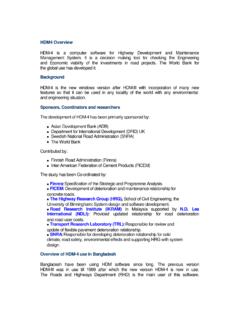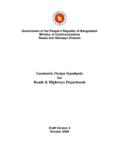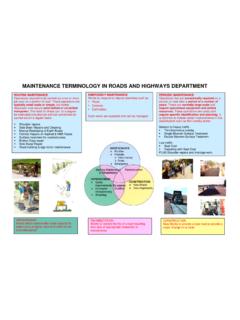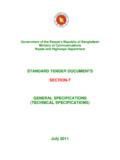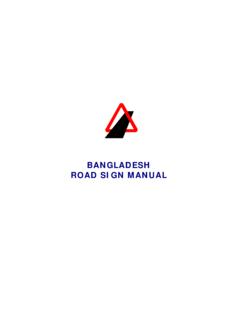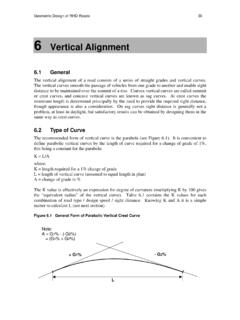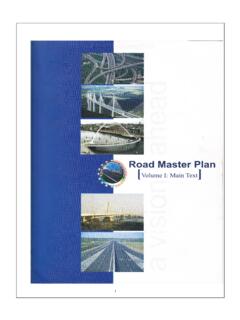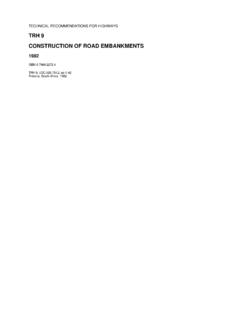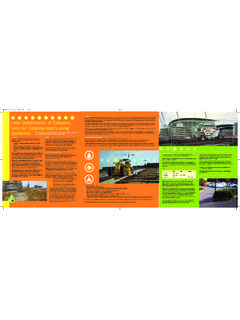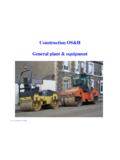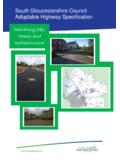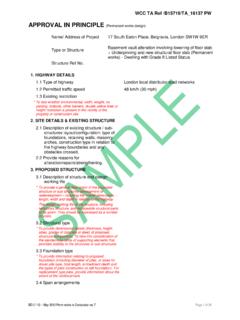Transcription of CONSTRUCTION PRACTICES AND PROCEDURES …
1 Government of the People s Republic of Bangladesh Ministry of Communications Roads and Highways Department CONSTRUCTION PRACTICES AND PROCEDURES manual MAY 2001 FOREWORD PROCEDURE manual May 2001 I FOREWORDtoConstruction PRACTICES and PROCEDURES ManualIt has long beenrecognised that the existing departmental Contract Proceduresand related documentation, need to be up-dated in order to ensure that theDepartment can operate more efficiently and effectively whilst producing field workof a consistently high the past few months several committees have reviewed currentdepartmental PRACTICES and contract documentation. These committees wereasked to formulate new PROCEDURES and documentation, which would be more inline withrecognised international forms of contract. The committees consisted ofsenior RHD Officers from both Headquarters Wings and Field Zones assisted byconsultants from IDC3 and new Contract Documentation consists of the following:Volume 1 - The TenderVolume 2 - The Conditions of ContractVolume 3 - Technical SpecificationsVolume 4 - DrawingsVolumes 2 and 3 are standard for all new RHD contracts and are therefore issuedas printed and bound books.
2 Volume 1 will be produced for each individualcontract but the document format and contract forms will remain which do not form a part of the Formal Contract Documents, butplay a vital part in the control of quality have also been produced. These include anew RHD Standard Test PROCEDURES manual and explanatory guides on a numberof CONSTRUCTION PRACTICES and PROCEDURES manual is intended to provide a quickfield guide to the CONSTRUCTION methods to be adopted for the most commonly usedconstruction items included in the SpecificationsThis document was prepared by consultants funded by GoB through RRMP2funds. My thanks go to them and to the RHD Officers of BRRL who assisted in theproduction of this document. My thanks are also due to the many ExecutiveEngineers of RHD who attended training at RHDTC under the control of SE (RHD) and Director RHDTC for the feedback 2001 Engr. ENGINEERR oads and Highways DepartmentSarakBhaban ,Ramna, DhakaINTRODUCTION PROCEDURE manual May 2001 II Introduction This Procedure manual provides a guide to the correct CONSTRUCTION PRACTICES and PROCEDURES for use on road contracts by the Roads and Highways Department.
3 This document is not intended to be comprehensive and therefore does not provide information on all CONSTRUCTION activities. It refers to the Standard Technical Specification; however, it does not replace any aspect of that document and if there is any conflict, the Specification takes precedence. Also for any activities not included in this manual , refer to the Standard or Particular Specification (if applicable) for details. The contractor is responsible for the method of CONSTRUCTION and quality of the constructed works and any work not undertaken in line with the Specification or with this document should be brought to the attention of more senior RHD officers (the Engineer) immediately. Throughout the site ( the area where the works are being constructed ) the contractor is responsible for supplying all the necessary signs and other equipment to ensure the smooth and safe flow of traffic.
4 Also the CONSTRUCTION should be carried out in a safe and controlled manner to prevent damage to vehicles and the general public from CONSTRUCTION equipment, site materials and activities. This document makes reference to materials testing, for example for determining in-situ densities, by referring to , these are tests included within the Standard Test PROCEDURES manual . Included in the appendices of this manual are: A summary of the material requirements and the compaction standards for each layer refer to Appendix A and Appendix B . The work sequence and the necessary laboratory testing for a road embankment refer to Appendix C . The test frequency to ensure the compliance of the material standards for each pavement layer refer to Appendix D . CONTENTS PROCEDURE manual May 2001 III CONTENTS Clearing, Grubbing and 1 6 Sub-grade.
5 11 Pavement Layers .. 15 Bituminous Layers and 25 Brick Pavement .. 43 Concrete including Reinforcement if required .. 44 Brickwork .. 52 CLEARING, GRUBBING AND EXCAVATION PROCEDURE manual May 2001 Page 1 of 52 CLEARING, GRUBBING AND EXCAVATION. Key Points Before any CONSTRUCTION the roadway must be cleared of all vegetation and trees including their roots removed. Cross sections should be taken prior to any excavation works. All CONSTRUCTION works must be carried out in as safe a manner as possible. Excavated suitable materials should be used when possible in the works. Provision has to be made for drainage of the temporary and permanent works. Soil containing vegetable matter is not suitable as fill material. Borrow pits should not affect the stability of the road, or any other structure. Clearing and Grubbing (Specification ) Before any CONSTRUCTION starts the roadway must be cleared of debris.
6 Unless there are specific reasons, agreed to by the Engineer in writing, all materials including trees, grass, crops and structures, which fall within the road alignment must be removed. Also all major stumps and roots need to be removed (grubbed out) and the holes left must be filled with compacted suitable fill material. Figure 1 shows an example of the clearing and grubbing which is required. CLEARING, GRUBBING AND EXCAVATION PROCEDURE manual May 2001 Page 2 of 52 Figure 1. Clearing and grubbing of roadwayCLEARING, GRUBBING AND EXCAVATION PROCEDURE manual May 2001 Page 3 of 52 Excavation (Specification , , , and ) General Before any excavation, including the removal of any areas of unsuitable materials, cross-sections should be taken of the undisturbed ground. From this information, and the cross sections taken of the completed road, earthwork quantities can be calculated.
7 No existing material, which will remain in the completed works, should be loosened unnecessarily during excavation. Excavation works, along with all CONSTRUCTION activities, must be undertaken in as safe a manner as possible to minimise the dangers to road users and the contractors personnel. Excavated Material Excavated materials need assessing as suitable or unsuitable. Suitable materials should be used when possible in the works. The excavated materials can be temporarily stockpiled, but must cause no damage to roads, services or property and not prevent water draining from the road or from the surrounding land. Any excess suitable material, which is not required for the CONSTRUCTION of the Works or any material classified as unsuitable is the property of RHD. The Contractor should stockpile these materials separately, as directed, or place the material in an approved location on site. To be suitable as fill material the soil must not contain any vegetable matter.
8 To be suitable as road pavement the requirements for sub base or base materials must be met. Materials excavated from existing road pavements may meet the necessary requirements directly, or after breaking and mixing with other materials. CLEARING, GRUBBING AND EXCAVATION PROCEDURE manual May 2001 Page 4 of 52 Drainage and Channel Excavation During CONSTRUCTION , ditches are required to be maintained to ensure proper drainage at all times. Any necessary ditches and channels should be constructed and maintained to ensure there is no damage to the roadway section. All existing ditches, or drainage channels, which the road crosses, need to be closed at the edge of the embankment, unless pipes or structures are to be constructed and, where necessary, alternative outfalls are to be provided. Any canals and channels which are located within the embankment area need to be cleaned up and then back filled with sand.
9 The sand fill should reach a level of 500 mm above the water level, but thereafter earthworks (as described in Embankments below) can be placed. Borrow Pits The borrow pits should be kept as drained as possible. Borrow pits should not be constructed where they might:- a) Affect the stability or safety of the highway, see Figure 2, or any railway or other structures, which may be present. b) Prevent natural or artificial drainage or irrigation. c) Damage adjacent property or future expansion plans for the highway. As materials are only paid for when included in the embankment, there is no need to measure the volume of material removed from any borrow pits. CLEARING, GRUBBING AND EXCAVATION PROCEDURE manual May 2001 Page 5 of 52 Figure 2. Borrow pits locationsEMBANKMENT PROCEDURE manual May 2001 Page 6 of 52 EMBANKMENT (Specification ) Key Points All fill materials must be free from vegetable matter and the material must be approved as suitable.
10 The material should be of an appropriate nature and at a moisture content that it can be compacted to form a stable layer. Generally embankments should be constructed in 150 mm compacted layers parallel to the finished grade of the road. For each completed layer the density should be checked (One test for each 1,000 square metres) by laboratory personnel. If test results show the required density is not achieved further compaction is necessary Any soft areas must be rectified before further material is placed. Each earthworks layer requires to be approved before the next layer can be started. Embankment CONSTRUCTION Methods Before placing any material, clearing and grubbing and the removal of any unsuitable materials needs to have been completed. Also any necessary information to determine earthwork quantities should have been collected (normally cross sections of the original ground). Where an existing embankment is widened, the new fill material must be fully keyed into the old embankment by means of benching.
